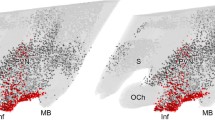Abstract
Binding sites for thyrotropin-releasing hormone (TRH) were labelled with [3H](2-Me-His3)TRH ([3H]MeTRH) on membranes from rat brain regions at 0°C for 5 h. Amygdaloid membranes bound [3H]MeTRH with high-affinity (K d=3.1±0.5 nM (n=4)). Five TRH analogs competed for this binding with the same rank order and with affinities that matched the pharmacological specificity of pituitary TRH receptors. Substance P (SP) and its C-terminal fragments reduced amygdaloid TRH receptor binding in a concentration dependent manner (IC50 for SP=65 μM). The rank order of potency of SP analogs at inhibiting TRH receptor binding was: SP>nonapeptide (3–11)>hexapeptide (6–11)>heptapeptide (5–11)>pentapeptide (7–11). However, other tachykinins were inactive in this system. SP was a potent inhibitor of [3H]MeTRH binding in hippocampus> spinal cord>retina>n. accumbens>hypothalamus>amygdaloid>olfactory bulb ≥pituitary>pons/medulla in parallel assays. In amygdaloid membranes SP (50 μM) reduced the apparent maximum receptor density by 39% (p<0.01) without altering the binding affinity, and 100 μM SP induced a biphasic dissociation of [3H]MeTRH with kinetics faster than those induced by both TRH (10 μM) and serotonin (100 μM). In contrast, other neuropeptides such as neurotensin, proctolin, angiotensin II, bombesin and luteinizing hormone releasing hormone did not significantly inhibit [3H]MeTRH binding to amydaloid membranes. Thus, the SP site with low affinity in the rat brain is not like any of the previously described tachykinin/neurokinin binding sites but resembles the site found on neuroblastoma cells (108CC15) and on adrenal chromaffin cells that modulate cation permeability and nicotinic receptors respectively. The physiological role of these atypical SP sites in the rat brain remains to be determined.
Similar content being viewed by others
References
Maggio, J. E., 1988. Tachykinins. Ann. Rev. Neurosoci. 11:13–28.
Sharif, N. A., 1985. Diverse roles of thyrotropin-releasing hormone in brain, pituitary and spinal cord function. Trends Pharmacol. Sci. 6:119–122.
Sharif, N. A., 1989. Quantitative autoradiography of TRH receptors in discrete brain regions of different mammalian species. Ann. New York Acad. Sci. 553:147–175.
Hökfelt, T., Tsurus, Y., Ulflake, B., Collheim, S., Arundsson U., Foster, G. A., Schultzberg, M., Schalling, M., Arborelius, L., Freedman, J., Post, C. and Visser, T. 1989. Distribution of TRH-like immunoreactivity with special reference to coexistence with other neuroactive compounds. Ann. New York Acad. Sci. 553:76–105.
Sharif, N. A., and Burt, D. R. 1983. Micromolar substance P teduces spinal TRH receptor binding-possible relevance to neutropeptide coexistence? Neurosci. Lett. 43:245–251.
Sharif, N. A., Towle, A. C., Burt, D. R., Mueller, R. A., and Breose, G. R. 1989. Co-transmitters: differential effects of serotonin (5-HT)-depleting drugs on 5-HT and TRH levels and their receptors in rat brain and spinal cord. Brain Res. 480:365–371.
Reiser, G., and Hamprecht, B. 1988. Characterization of a substance P receptor activating a cation permeability in neuronal cell lines. Europ. J. Pharmacol. 145:273–280.
Simasko, S. M., Soares, J. R. and Weiland, G. 1985. Structure-Activity Relationship for substance P inhibition of Carbamylchohen-stimulated22Na+Flux in neuronal (PC12) and non-neuronal (BC3Hl) cell lines. J. Pharmacol. Expt. Ther. 235:601–605.
Sharif, N. A., 1985. Low-affinity Substance P receptors modulate TRH-receptor interactions: tissue specificity and effects of other drugs. Brit. J. Pharmacol. 84:66p.
Sharif, N. A. and Burt, D. R. 1983. Rat brain TRH receptors: kinetics, pharmacology, distribution and ionic effects. Regul. Peptides. 7:399–411.
Lowry, O. H., Rosebrough, N. J., Farr, A. L. and Randall, R. J. 1951. Protein measurement with the Folin reagent. J. Biol. Chem. 193:265–275.
Burt, D. R. and Taylor, R. L. 1980. Binding sites for thyrotropinreleasing hormone in sheep nucleus accumbens resemble pituitary receptors. Endocrinology, 106:1416–1423.
Burt, D. R., and Sharif, N. A. 1984. Peptide receptors, Pages 353–378,in A. Lajtha, (ed), Handbook of Neurochemistry, Vol. 6 Chapter 13, Plenum Press, New York.
Burt, D. R., and Sharif, N. A. 1990. TRH receptors, pages 477–503in A. Bjorklund, Hökfelt, T., and M. J. Kuhar, (eds.), Handbook of Chemical Neuroanatomy Vol. 9, Chapter 9, Academic press.
Hinkle, P. M., 1989. Pituitary TRH receptors. Ann. New York Acad. Sci. 554:176–187.
Quirion, R., 1985. Multiple tachykinin receptors. Trends Neurosi. 8:183–185.
Pernow, B., 1983. Substance P, Pharmacol, Rev. 35:85–141.
Lee, C.-M., Iversen, L. L., Hanley, M. R., and Sandberg, B. E. B. 1982. The possible existence of multiple receptors for substance P. Naunyn-Schmiedeberg's Arch. Pharmacol. 318:281–287.
Cascieri, M. A., Chicchi, G. G., and Liang, T. 1985. Demonstration of two distinct tachykinin receptors in rat brain cortex. J. Biol. Chem. 260:1501–1507.
Hanley, M., Lee, C., Watson, S., Sandberg, B., Iversen, L. 1981. Biochemical and pharmacological studies of SP receptors. Protides Biol Fluids 82:477–485.
Nemeth, E. F., and Cooper, J. R. 1979. Effect of Somatostatin on acetylcholine release from rat hippocampal synaptosomes. Brain Res. 165:166–170.
Tang, J., Chow, H., Yang, H.-Y. T., and Costa, E. 1983. SP stimulates the release of Met5-enkaphalin-Arg6-Phe7 and Met5-enkephalin from rat spinal cord. Neuropharmacology, 35:1150–1152.
Reubi, J. C., Emson, P. C., Jessell, T. M., and Iversen, L. L. 1978. Effects of GABA, Dopamine, and Substance P on the release of newly synthesized3H-5-Hydroxytryptamine from rat substantia Nigra in vitro. Naunyn-Schmiedeberg's Arch. Pharmacol. 304:271–275.
Trembley, L. E., Maheux, R., and Bedard, P. J. 1986. Substance P in the lumbar spinal cord of the rat effects the motor response to 5-HTP and TRH. Neuropharmacology, 25:419–424.
Freedman, J. T., Hökfelt, T., Jansson, G., and Post, C. 1986. Thyrotropin releasing hormone (TRH) counteracts neuronal damage induced by a substance P-antagonist. Exp. Brain Res. 62:175–181.
Livett, B. G., Kozousek, V., Mizobe, F., and Dean, D. M., 1979. Substance P inhibits nicotinic activation of chromaffin cells. Nature 278:256–257.
Author information
Authors and Affiliations
Additional information
A preliminary account of these studies has been presented to the British Pharmacological Society (9).
Rights and permissions
About this article
Cite this article
Sharif, N.A. A novel substance P binding site in rat brain regions modulates TRH receptor binding. Neurochem Res 15, 1045–1049 (1990). https://doi.org/10.1007/BF00965752
Accepted:
Issue Date:
DOI: https://doi.org/10.1007/BF00965752




